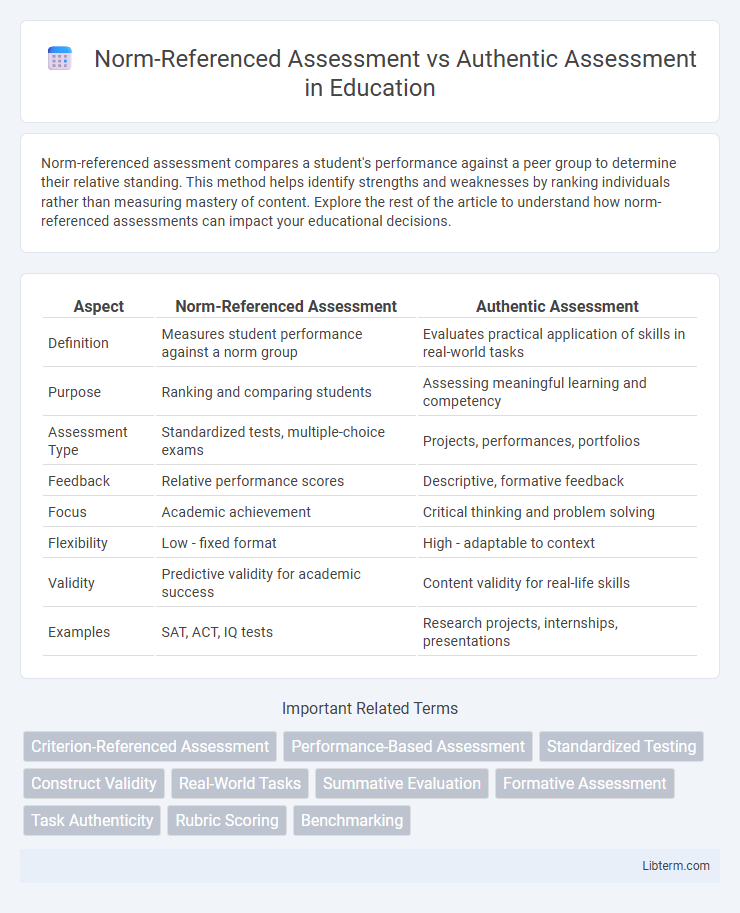Norm-referenced assessment compares a student's performance against a peer group to determine their relative standing. This method helps identify strengths and weaknesses by ranking individuals rather than measuring mastery of content. Explore the rest of the article to understand how norm-referenced assessments can impact your educational decisions.
Table of Comparison
| Aspect | Norm-Referenced Assessment | Authentic Assessment |
|---|---|---|
| Definition | Measures student performance against a norm group | Evaluates practical application of skills in real-world tasks |
| Purpose | Ranking and comparing students | Assessing meaningful learning and competency |
| Assessment Type | Standardized tests, multiple-choice exams | Projects, performances, portfolios |
| Feedback | Relative performance scores | Descriptive, formative feedback |
| Focus | Academic achievement | Critical thinking and problem solving |
| Flexibility | Low - fixed format | High - adaptable to context |
| Validity | Predictive validity for academic success | Content validity for real-life skills |
| Examples | SAT, ACT, IQ tests | Research projects, internships, presentations |
Introduction to Assessment Types
Norm-referenced assessment compares a student's performance to a predefined group, typically using standardized tests to rank test-takers and identify relative achievement levels. Authentic assessment evaluates students' skills and knowledge through real-world tasks, projects, or performances that demonstrate applied understanding and practical competencies. These two assessment types serve distinct educational purposes: norm-referenced focuses on comparative measurement, while authentic assessment emphasizes meaningful, context-based evaluation.
Defining Norm-Referenced Assessment
Norm-referenced assessment evaluates a student's performance by comparing it to a predefined group, establishing rankings based on relative achievement rather than absolute mastery. This method uses standardized tests with fixed scoring systems to determine percentile ranks, highlighting individual standing within a norm group. The primary goal is to identify how students perform in relation to peers rather than measuring specific learning outcomes or competencies.
Understanding Authentic Assessment
Authentic assessment measures student learning through real-world tasks that reflect practical applications, emphasizing critical thinking and problem-solving skills. Unlike norm-referenced assessments, which compare students against peers using standardized tests, authentic assessments focus on individual mastery and meaningful engagement with content. This approach provides a comprehensive understanding of a student's abilities by evaluating performance in contexts that resemble actual challenges outside the classroom.
Key Differences Between Norm-Referenced and Authentic Assessment
Norm-referenced assessment measures student performance by comparing individuals against a statistically defined norm group, emphasizing ranking and relative achievement. Authentic assessment evaluates students through real-world tasks that demonstrate practical application, critical thinking, and mastery of specific skills without comparison to peers. Key differences include norm-referenced assessments prioritizing standardized testing and scoring curves, while authentic assessments focus on personalized, performance-based evidence of learning outcomes.
Purposes and Applications of Norm-Referenced Assessment
Norm-referenced assessments are designed to compare a student's performance against a broader population, providing percentile ranks and standardized scores to identify relative standing. These assessments are primarily applied in large-scale testing environments such as college admissions, placement tests, and national benchmarks to categorize and rank learners systematically. Their purpose centers on sorting and selecting individuals by performance rather than measuring mastery of specific content or skills.
Real-World Relevance of Authentic Assessment
Authentic assessment emphasizes real-world relevance by evaluating students through tasks that mirror practical challenges and professional practices distinct from norm-referenced assessments that compare student performance against peers. This approach fosters critical thinking, problem-solving, and application of knowledge in genuine contexts, enhancing skills that are directly transferable to real-life situations. By integrating authentic tasks such as projects, presentations, and portfolios, authentic assessment provides a deeper insight into students' abilities and prepares them for career and life challenges.
Advantages and Limitations of Each Assessment Type
Norm-referenced assessment enables educators to compare student performance against a defined population, providing a clear ranking that aids in identifying top performers and addressing achievement gaps, but it may overlook individual learning progress and contextual factors. Authentic assessment emphasizes real-world tasks and practical skills, fostering deeper understanding and student engagement, yet it can be time-consuming to design, subjective in scoring, and challenging to standardize across diverse learners. Balancing these assessments requires considering the purpose of evaluation, with norm-referenced measures offering broad benchmarking and authentic assessments promoting meaningful, skills-based evaluation.
Impact on Student Learning and Motivation
Norm-referenced assessment compares student performance against peers, often leading to competitive environments that may undermine intrinsic motivation and limit personalized learning growth. Authentic assessment evaluates students through real-world tasks, fostering deeper engagement and promoting meaningful skill development by connecting learning to practical applications. Research indicates authentic assessment enhances student motivation and understanding by emphasizing mastery and relevance rather than relative ranking.
Choosing the Right Assessment for Educational Goals
Norm-referenced assessment compares student performance against a predefined population, providing percentile ranks and standardized scores essential for evaluating relative achievement and identifying gaps. Authentic assessment evaluates students' ability to apply knowledge and skills in real-world contexts, offering deeper insights into critical thinking, problem-solving, and creativity aligned with curricular objectives. Selecting the appropriate assessment depends on educational goals: norm-referenced tools suit benchmarking and selection purposes, while authentic assessments better measure meaningful learning and skill mastery.
Conclusion: Balancing Assessment Methods
Balancing norm-referenced assessment and authentic assessment fosters a comprehensive evaluation of student performance by incorporating standardized benchmarks and real-world applicability. Norm-referenced assessments provide valuable comparative data on student achievement, while authentic assessments emphasize critical thinking and practical skills development. Integrating both methods ensures a holistic approach that supports diverse learning objectives and improves educational outcomes.
Norm-Referenced Assessment Infographic

 libterm.com
libterm.com